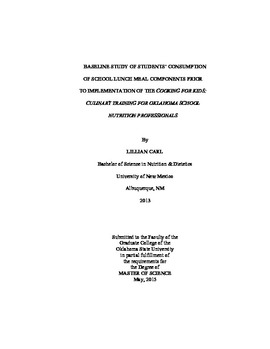| dc.description.abstract | Since implementation of the Healthy Hunger-Free Kids Act (HHFKA), 2010, school cafeterias are seeing a decline in students' school meal consumption. Cooking for Kids is a 5-year program that aims to train and provide food service consulting to Oklahoma school districts participating in the School Breakfast Program and National School Lunch Program to improve the quality and student consumption of school meals following the new revisions developed by the USDA Food and Nutrition Service in response to the HHFKA. This study's purpose was to 1) establish a baseline measure of Oklahoma students' consumption of lunch meal components (i.e., entr�e, grain, vegetable, and fruit) prior to the implementation of the pilot culinary training program, and 2) compare trends between geographic location (urban versus rural), grade level (elementary versus secondary), and meal preparation system (central/satellite versus on-site kitchen). A consumption analysis was conducted in six school sites from Oklahoma school districts in spring 2014. Of the 1524 observations, students ate � of the entr�e, half the grain serving, and less-than-half of the vegetable and fruit servings. Students attending urban schools, compared to rural, consumed significantly more of the entr�e (0.77�0.01, 0.70�0.02 respectively) and vegetable (0.48�0.01, 0.39�0.02 respectively) (P≤0.001). Middle/high school students, compared to elementary school students, ate significantly more entr�e (0.81�0.01, 0.68�0.01 respectively), grain (0.70�0.03, 0.48�0.02 respectively), and vegetable servings (0.51�0.02, 0.38�0.01 respectively) (P≤0.001). Controlling for grade level, the meal preparation system did not make a difference in consumption. Culinary-training efforts should focus on fruits, vegetables and whole grains and address preparation methods of these food items as well as menu planning approaches to increase variety of items offered. Additionally, identifying differences in menus served in urban versus rural schools and to elementary versus secondary school age students may identify strategies that contribute to increased consumption. | |
